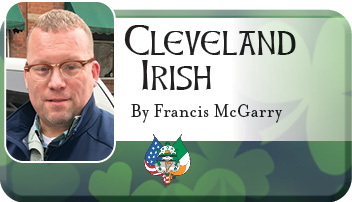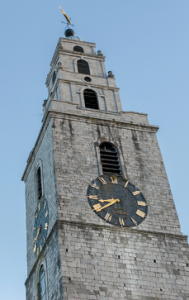

Cleveland Irish: For Whom the Bells Toll
By Francis McGarry
The bells in Ireland were formerly called crotals, a term that appears to be from the old Irish. The crotals were used by the clergy and the druids before them. Some scholars believe the early crotals were used to frighten ghosts.
John O’Phelan’s collections of epitaphs in the cathedral of St. Canice at Kilkenny denote the first bell erected in a church in Ireland was given to St. Kieran by St. Patrick. It was mounted in St. Kieran’s church, near Birr. Birr is 86 KM south of Newton Forbes and 101 KM to the east is Galway City.
The Catholic Bell
Church bells, in some form, have been in use since 400 CE. Semantron, a flat plate of metal, similar to a gong, was used to announce the beginning of service in Greek monasteries. Those early flat metal instruments evolved in Ireland to the bells we see today, four sided and much bigger. Bells were also popular in areas traveled to by Irish missionaries.
St. Peter’s in Rome, during the time of Ermharius (who died in 738 CE), had a bell made to hang in the little tower, or turricula. A monastic bell maker petitioned Charlemagne for funding for a church bell.
I once met a girl at a bar in the Atlanta airport who claimed to be related to Charlemagne. I retorted that I was related to John the Baptist; actually Jon-Jon is a Baptist and like a brother to me.
Early ninth century Frankish parishes were expected to have a least one bell. Notre-Dame de Paris has ten bells, which are rung every fifteen minutes, but in French. In 2012, four of the major bells at Notre-Dame were replaced with new bells.
Bells are cast from a bronze alloy, but they do not last forever, as any campanologue will tell you. The “Bourdon Emmanual” bell, cast in 1686, remains in the south tower at Notre-Dame. The bell tower at the Basilica of the Sacred Heart (Notre Dame, IN) is 230 feet tall, making it the tallest university chapel in America.
For Whom the Bell Tolls
John Donne, not a Baptist, was born in London in 1572 to recusant Catholic parents. At the time it was illegal to practice Catholicism in England. His father was married to Elizabeth Heywood, whose brother was a Jesuit priest. She was great niece to Thomas More.
Donne is noted for his three moods of love in his poetry: cynical love, which was anti-woman, conjugal love, or married life, and Platonic love, which was spiritual. He married Anne More, daughter of Sir George More, in 1601 and had twelve children. Under the order of the King, Donne was ordained as an Anglican priest in 1615.
In 1624 he published Devotions Upon Emergent Occasions, which included For Whom the Bell Tolls.
No man is an island, entire of itself. E
ach is a piece of the continent, a part of the main.
If a clod be washed away to sea, Europe is the less.
As well is a promontory were.
As well as if a manor of thine own or of thine friend’s were.
Each man’s death diminishes me, for I am involved in mankind.
Therefore, send not to know for whom the bell tolls,
it tolls for thee.

The Irish Bells of Cleveland
Immaculate Conception Church, the Mac, was charted by Bishop Rappe in 1855. The first structure at 41st and Superior was the Church of the Nativity, which was relocated from the Cathedral. A temporary structure was built and housed the church and school for the next decade. The Fenians, on their way to invade Canada in the name of Irish independence, stashed their rifles at Immaculate Conception in 1866.
On August 17th, 1873 the cornerstone of the Mac was laid, witnessed by some 10,000 Cleveland residents. The bell towers were built 275 feet tall and still house twelve bells, ranging from 250 pounds to 3,500 pounds. The bells were baptized and are listed in the baptismal record.
Martin Luther claimed the rite of baptizing bells as superstition and a profanation of the sacrament. That did not matter to the Irish on 41st and Superior. Each bell is inscribed with the names of the benefactors.
Their donations were made knowing that no one would see their names on the bells in the towers. Irish names are on those bells, all Irish names. Since 1899, Cleveland has heard their donations.
This was Father Godic’s homily, a story of the Irish bells at his parish. He is Slovenian and praised the Irish monks who traveled to his land, before his time, and preached the gospel. Like Modestus, the “Apostle of Ceratonia,” who in 720 CE converted the Cerantanians in north-eastern Slovenia. He was Irish by birth and a disciple of St. Fergal.
Father Thomas Thorpe built those towers and that church. He was born near Dublin in 1838. After starting his studies in Ireland, he finished his priestly preparation in Cleveland and was ordained by Bishop Rappe in 1861.
Father Thorpe was named Monsignor in 1891 and a Prelate of the Papal Household in 1895. His obit honors the major building projects at Immaculate Conception and at the Cathedral. He also launched the Catholic Universe, a Catholic newspaper, and served as its editor for three years.
Throughout the history of the church, bells have been rung in a variety of ways to signal to the faithful when and what to pray. The Angelus Bell was rung at 6am, noon and 6pm. It consists of three strikes of the lowest bell, three times. Church bells have announced Mass, Matins and Vespers. The bells at the Mac have been rung for all those occasions. Can you hear the names on the bells when they ring?
We did not know this narrative as we sat in the pews at our Hibernian Mass listening to Father Godic. Some of the Hibernians had never been to Mass at the Mac. That Mass and that homily changed the way we listen to those bells.
As Cleveland Irish, we are a part of our own history. We are the today to our brethren’s yesterday. We are involved in the history of the Irish in Cleveland and not knowing that history, all of that history, diminishes all of us.
The bells at the Mac continue to ring and can be heard every day. Are you listening? Can you hear the names on those bells? Those bells tell our story and they toll for all of the Irish in Cleveland.
*Francis McGarry holds undergraduate degrees from Indiana University in Anthropology, Education and History and a Masters in Social Science from the University of Chicago. He is the Executive Director of Bluestone Hibernian Charities and proprietor of McGarry Consulting. Francis is the founder and a past president of the Bluestone Division of the Ancient Order of Hibernians and a past president of the Irish American Club East Side.

Monthly newsmagazine serving people of Irish descent from Cleveland to Clearwater. We cover the movers, shakers & music makers each and every month.
Since our 2006 inception, iIrish has donated more than $376,000 to local and national charities.
GET UPDATES ON THE SERIOUS & THE SHENANIGANS!